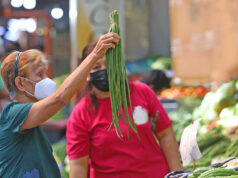Chateau Pichon Baron: Your insurance wine
LAST February, I probably had my last social dinner (as we knew it before the pandemic) at the Wine Story in Uptown BGC. Little did I, along with some 30 other attendees, including the winery representative from the French chateau, realize that this may have been our last wine dinner of this kind for the foreseeable future, as COVID-19 has since swept away normalcy from the city, the country and the entire world. But even with the present narrative, this wine dinner featuring second growth royalty Chateau Pichon Baron, also known as Chateau Pichon Longueville Baron, could easily be one for the ages. Kudos once more to Romy Sia, the head honcho of Wine Story for pulling this one off.
TALE OF TWO CHATEAU PICHONS
There are three Chateau Leovilles in St.-Julien: Leoville Las Cases, Leoville-Poyferre and Leoville Barton — spinoffs from the larger Leoville prime parcel, same is the case with the two Pichons in Pauillac. And all these Leoville and Pichon wines are classified in the original 1855 Official Bordeaux Classification as Deuxièmes Crus (Second Growths). Even though the vineyard parcel known then as Pichon-Longueville started in mid 1600s, it was only by 1850 that the split of the two Pichons happened. Generational heir Baron Joseph Pichon-Longueville at his very old dying age decided to divide his large estate among his five children: his two sons and three daughters.
The sons would be teamed up, and would also inherit the chateau and the winery, the same one that still exists as Chateau Pichon Baron. One of the daughters, Virginie, married Charles Henri, the Comte (or Count) of Lalande in 1818, and therefore together with her two other female siblings, would form the other side of the Pichon-Longueville property, known as Pichon Comtesse de Lalande or Pichon Lalande.
These two prestigious chateaux are now owned by different entities. Chateau Pichon Lalande is now under the same ownership as luxury champagne house Louis Roederer, while Pichon Baron has been owned by the humongous French multinational insurance company, AXA since 1987. AXA also owns Château Suduiraut in Sauternes (a classified premier grand cru from the white Bordeaux counterpart of the same 1855 Classification), Quinta do Noval in Portugal, Disznoko winery in Tokaj, Hungary, Domaine de l’Arlot in Nuits-Saint-Georges in Burgundy and Outpost Winery in Napa Valley, California. Just this March, AXA sold one of its wineries, Chateau Petit-Village from Pomerol Bordeaux, to a fellow Pomerol estate, Château Beauregard.
THE MASCULINE PICHON
When the division on the Pichon property took place, dichotomizing the sons from the daughters, it somehow also reflected a style difference that would embody each respective chateau. The Pichon Baron wines would show a brusque masculine angle, captivated by lots of fruit intensity, rustic tannins, bolder flavors and heavy body, while the Pichon Lalande wines would seem more feminine, more perfumed, with a silkier texture, and also easier to approach when young. Yet these two properties are literally facing each other along the D2 road in Medoc, but very distinguishable when it comes to the liquid inside their respective bottles.
The main reason may be that Pichon Baron uses more Cabernet Sauvignon in its blend (70% on average), while Pichon Lalande uses less Cabernet Sauvignon (though it is still the dominant varietal), and has more significant percentage of Merlot, Cabernet Franc and Petit Verdot.
SPECIAL ONE-OF-A-KIND NIGHT
Xavier Sanchez, the commercial and marketing director of the AXA wine group, came all the way from Bordeaux just to grace this one Baron Pichon wine dinner at Wine Story Uptown BGC — this despite the already scary buzz on the coronavirus in early February. What made this wine dinner even much more special was that four of the Chateau Pichon Baron wines being tasted came from rare double magnum (three-liter) bottles: namely the 2014, 2009, 2002, and 1988.
Also, we got a rare opportunity to taste a very finite 63-year-old vintage, the Chateau Pichon Baron 1957. And then, there was more.
I was lucky to be seated at the same table as Romy Sia and Xavier Sanchez, as well as a very generous Wine Story patron named Edison. Edison happened to be born in 1957, the same year as the vintage of the old Pichon Baron in the tasting flight. As a nice gesture in front of Xavier, Edison decided to buy on the spot a Pichon Baron 1989 to share with all of us in the same table. Not to be outdone, Romy Sia also took out a Pichon Baron 1990 to pour at our table. Total, I had seven different Pichon Barons, including the stunning and arguably best three consecutive vintages of Bordeaux: 1988, 1989, and 1990. And all from a super second-growth chateau! So, how could this be not the best wine vertical tasting of my life?!
CUSTOMARY TASTING NOTES
These Chateau Pichon Baron vintages below were tasted in this order:
Chateau Pichon Baron 2014: “noticeable young acids, violets, black cherries, silky, still young and rustic, dark fruits, long, good viscosity”; this wine was the first of several vintages, and it set the right tone for the rest of the Pichon Baron vintages;
Chateau Pichon Baron 2009: “bold flavors, violets, cinnamon bark, fowl-nose, crusty, earthy, supple, round, lingering raisins, dry flinty finish”; my second favorite wine from this vertical range, and I love it for its depth, complexity and huge durability potential — easily one to be enjoyed for decades to come;
Chateau Pichon Baron 2002: “peppercorn, cinnamon, violets, firm texture, long, round, toasty, coffee-tart finish”; not as much richness as I come to expect from a Pauillac, but given that it was not from a touted vintage, the signature Pichon Baron quality still offered a great tipple;
Chateau Pichon Baron 1988: “long, lengthy nose, still vivacious, vibrant, anise, black currant, supple body, burned/charcoaled, creamy and soft finish”; a wine that taste much younger than its age, easily one of my favorites from this lot’
Chateau Pichon Baron 1957: “cigar box, color still good, but acid is fading, passed its prime but still very drinkable, stewed tomatoes, subtle berry flavors, and easy quaffable finish”;
Chateau Pichon Baron 1989: “vanilla, herbal, black pepper, overripe berries, unctuous, dry and long on the palate, minerally finish”; my favorite wine from the batch, and probably because at this stage of drinking, at 31 years old, the wine was already open, exuding such delectable flavors and with enough complex elements; divine from first quaff onwards; and,
Chateau Pichon Baron 1990: “forest nose, racy, lively, still fresh, raisins, herbaceous, black truffles, peppercorn, plummy, caramel, and luscious at the end”; another one of my favorites — again my palate got so spoiled this evening, and at any other tasting, this could have easily been my best wine of the night.
As evidenced by its time-tested reputation, and this surreal multiple vintage tasting I was part of, Chateau Pichon Baron wines are almost risk-free with guaranteed high quality, a so called “insurance” wine that its owner, AXA only knows too well of.
How can we top this wine dinner?… maybe we cannot, or perhaps only a Romy Sia and his Wine Story can do an encore. For now, let us all once again pray and hope that this COVID-19 menace will be over soon. The little pleasures we have, like enjoying fine wines, may take a newer meaning now. Let us all be grateful and thankful. Belated Happy Easter to all.
For more information on Wine Story, please visit their website at www.winestory.com.ph.
The author is a member of the UK-based Circle of Wine Writers (CWW). For comments, inquiries, wine event coverage, wine consultancy and other wine related concerns, e-mail the author at protegeinc@yahoo.com.



